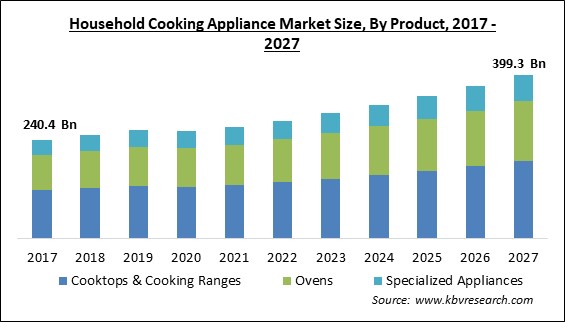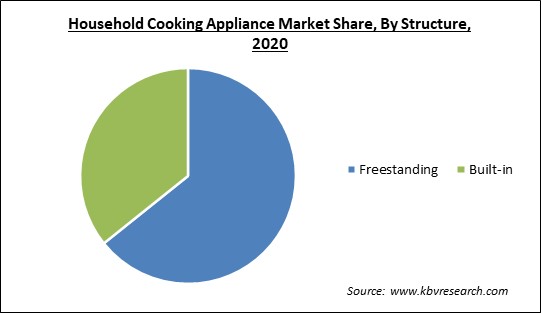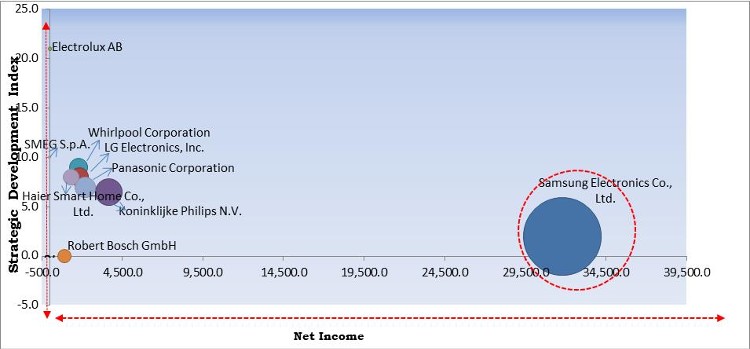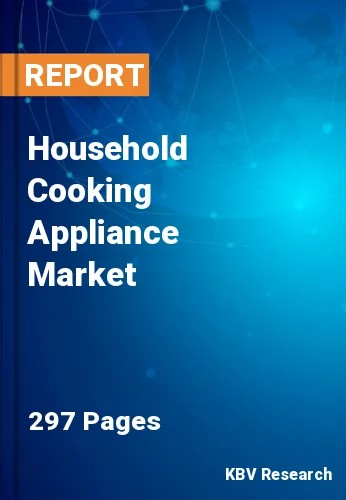The Global Household Cooking Appliance Market size is expected to reach $399.3 billion by 2027, rising at a market growth of 6.7% CAGR during the forecast period.
Microwaves, cook-tops, ovens, and range hoods are examples of cooking appliances. Chefs benefit from the usage of modern cooking appliances. In addition, with the growing natural resource depletion like LPG and other petroleum products, it is critical to employ efficient and environmentally friendly kitchen appliances. To enhance their market share, key players are producing advanced cooking equipment while also contributing to environmental preservation.
The need for worldwide cooking appliances is driven by population growth, limited natural resources, and climate change. The kitchen appliance industry is boosted by rising disposable income, an increase in the number of working women professionals, and the adoption of western culture in eastern developing countries like India and Indonesia. Fast-paced and hectic lifestyles, as well as the need for high-quality cooking products, would fuel the demand for kitchen appliances in developed regions. For growth potential and acceptance of advanced cooking appliances, emerging regions have the most to offer. Expanding into Asia- Pacific markets, like India, Indonesia, and China is likely to open up several opportunities for market growth in the future. Additionally, the number of working-class women is growing, and families are becoming more financially stable. As a result, families today consider high-tech kitchen gadgets to be a fair investment that not only saves time but also streamlines complex cooking activities.
Over the projected period, the market is anticipated to develop due to an increase in the number of nuclear families, changing dietary tastes, and an increase in the count of working women and single professionals. Stringent energy efficiency laws in several areas of the world, simple availability of household kitchen equipment on e-commerce websites, increasing preference for home automation, and continuing introductions of smart cooking items are projected to fuel the market growth.

As a consequence of the temporary shutdowns of industrial plants, personnel shortages, and delayed logistics operations, the COVID-19 pandemic made a worse impact on market growth in early 2020. The difficulties are due to the rigorous restrictions, including lockdowns, implemented by various countries around the world to stop the sickness from spreading. As a result, market participants first faced declining sales. However, as governments eased some of the prohibitions, internet sales of household goods gained traction in particular. Besides e-commerce portals, physical stores reopened, and sales of culinary equipment climbed as the majority of people continued to work remotely and spent significant amounts of time in their homes. Once lockdown restrictions are uplifted, it has become easier for household cooking appliance market to recover and that too on rapid rate.
Companies currently are primarily focused on manufacturing energy-efficient home appliances to give customers sustainable and home pleasure solutions. Furthermore, the government's recent favorable rules encouraging the creation of high-power rated appliances have raised the demand for these types of appliances that consume much less energy. For example, India's Bureau of Energy Efficiency (BEE) established an energy efficiency baseline for various types of kitchen appliances in March 2018, allowing companies to manufacture energy-efficient equipment in the country. Furthermore, the increasing popularity of having a modular kitchen has increased the demand for such kitchen-related equipment.
To meet consumer needs for technologically advanced home appliances, companies are primarily focusing on introducing smart kitchen equipment. This is likely to entice people to purchase such products, hence propelling the industry forward. For example, during the 2020 International CES innovation summit in March 2020, Samsung Electronics Co. Ltd. unveiled novel appliance goods like custom and induction cooktops, cube refrigerators, and shoe care systems. Furthermore, rising knowledge of the availability of a wide range of small & large smart kitchen equipment is primarily driving demand for such items. The expansion of the overall household cooking appliances market is being aided by expanding online purchasing patterns.
The high demand from consumers to keep and repair various types of household appliances is limiting the market's expansion. Furthermore, the increased cost of smart kitchen appliances is expected to limit demand among people with lesser income. Huge competition from local industry participants is creating a threat to big firms' commercial growth. These issues are likely to stifle market expansion. The initial investment of an industrial oven is one of the biggest hurdles to the development of the Industrial Oven Market. As a result, many small businesses are hesitant to invest in industrial ovens and remain dependent on traditional systems for a variety of tasks.

Based on Product, the market is segmented into Cooktops & Cooking Ranges, Ovens, and Specialized Appliances. Based on Cooktops & Cooking Ranges Type, the market is segmented into Gas-based, Electrical-based, and Induction-based. Based on Ovens Type, the market is segmented into Conventional & Convection, Microwave, and Combination. The Ovens segment garnered a significant revenue share in the household cooking appliance market in 2020. The oven's capacity to cook restaurant-quality meals in homes bodes well for the segment's future growth. The market has been divided into convection and convention, microwave, and combination segments based on heating technology. In 2020, the combination ovens sub-segment will have a dominant share of the total ovens segment. Combination ovens are becoming more popular as part of today's home culinary lifestyle.
Based on Structure, the market is segmented into Freestanding and Built-in. The Bulit-in segment procured a substantial revenue share in 2020. Built-in household cooking appliances, on the other hand, are favored for the smaller kitchens. They take up less room because they are used as design components in modular kitchens. As a result, over the projection period, the built-in sector is anticipated to grow. Built-in equipment, on the other hand, incurs additional installation charges because these appliances must be installed by professionals.
Based on Distribution Channel, the market is segmented into Brick & Mortar and E-commerce. The Brick & Mortar segment acquired the maximum revenue share in the household cooking appliance market in 2020. It is due to the fact that some customers want to see demo and physical analyze the condition of the appliance before making a purchase. In addition, the after-purchase services of offline stores are considered to be convenient for many people, which is fueling the growth of the segment. Customers can have a first-hand experience at physical stores, and the tangibility of the product may contribute to swift purchasing decisions.
| Report Attribute | Details |
|---|---|
| Market size value in 2020 | USD 260.5 Billion |
| Market size forecast in 2027 | USD 399.3 Billion |
| Base Year | 2020 |
| Historical Period | 2017 to 2019 |
| Forecast Period | 2021 to 2027 |
| Revenue Growth Rate | CAGR of 6.7% from 2021 to 2027 |
| Number of Pages | 297 |
| Number of Tables | 513 |
| Report coverage | Market Trends, Revenue Estimation and Forecast, Segmentation Analysis, Regional and Country Breakdown, Competitive Landscape, Companies Strategic Developments, Company Profiling |
| Segments covered | Product Type, Structure, Distribution Channel, Region |
| Country scope | US, Canada, Mexico, Germany, UK, France, Russia, Spain, Italy, China, Japan, India, South Korea, Singapore, Malaysia, Brazil, Argentina, UAE, Saudi Arabia, South Africa, Nigeria |
| Growth Drivers |
|
| Restraints |
|
Based on Regions, the market is segmented into North America, Europe, Asia Pacific, and Latin America, Middle East & Africa. Asia Pacific garnered the maximum revenue share in the household cooking appliance market in 2020. Due to cheap labour costs and the availability of raw materials at affordable prices, the region has emerged as a key production hub for domestic kitchen appliance manufacturers. As an outcome, major manufacturers from various parts of the world are increasing their operations in the Asia Pacific. Over the forecast period, the regional market is likely to develop due to continued urbanization, rising consumer spending power, increasingly changing lifestyles and early acceptance of novel technology.
Free Valuable Insights: Global Household Cooking Appliance Market size to reach USD 399.3 Billion by 2027

The major strategies followed by the market participants are Product Launches. Based on the Analysis presented in the Cardinal matrix; Samsung Electronics Co., Ltd. is the forerunners in the Household Cooking Appliance Market. Companies such as Koninklijke Philips N.V., Whirlpool Corporation, LG Electronics, Inc. are some of the key innovators in the Market.
The market research report covers the analysis of key stake holders of the market. Key companies profiled in the report include Koninklijke Philips N.V., Whirlpool Corporation, Samsung Electronics Co., Ltd. (Samsung Group), LG Electronics, Inc. (LG Corporation), Panasonic Corporation, Robert Bosch GmbH, Haier Smart Home Co., Ltd. (Haier Group Corporation), SMEG S.p.A, Electrolux AB, and WINIA Electronics Co., Ltd.
By Product
By Structure
By Distribution Channel
By Geography
The household cooking appliance market size is projected to reach USD 399.3 billion by 2027.
Increased Use of Energy-Efficient Kitchen Appliances are driving the market in coming years, however, higher maintenance and repair cost limited the growth of the market.
Koninklijke Philips N.V., Whirlpool Corporation, Samsung Electronics Co., Ltd. (Samsung Group), LG Electronics, Inc. (LG Corporation), Panasonic Corporation, Robert Bosch GmbH, Haier Smart Home Co., Ltd. (Haier Group Corporation), SMEG S.p.A, Electrolux AB, and WINIA Electronics Co., Ltd.
COVID-19 pandemic made a worse impact on market growth. The difficulties are due to the rigorous restrictions, including lockdowns, implemented by various countries around the world to stop the sickness from spreading.
The Cooktops & Cooking Ranges segment acquired the maximum revenue share in the Global Household Cooking Appliance Market by Product in 2020, thereby, achieving a market value of $188.0 billion by 2027.
The Asia Pacific market dominated the Global Household Cooking Appliance Market by Region in 2020, and would continue to be a dominant market till 2027.
Our team of dedicated experts can provide you with attractive expansion opportunities for your business.

